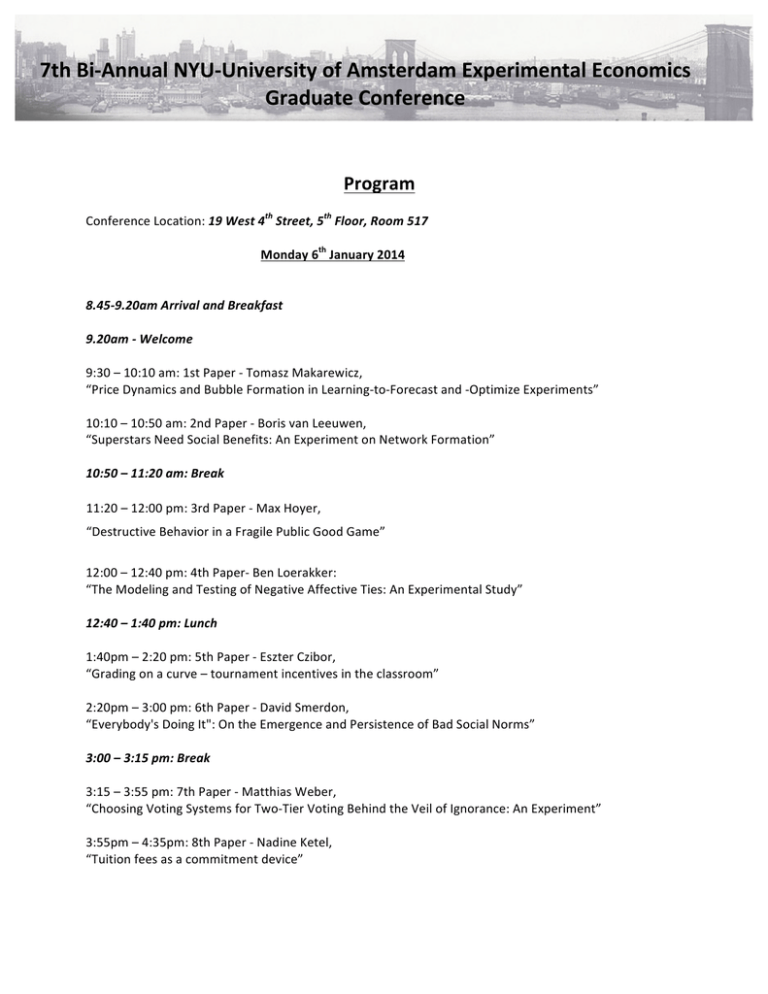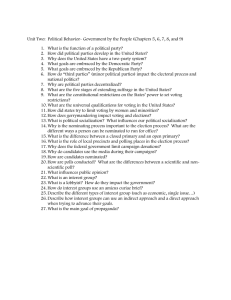Document 10622232
advertisement

7th Bi-­‐Annual NYU-­‐University of Amsterdam Experimental Economics Graduate Conference Program Conference Location: 19 West 4th Street, 5th Floor, Room 517 Monday 6th January 2014 8.45-­‐9.20am Arrival and Breakfast 9.20am -­‐ Welcome 9:30 – 10:10 am: 1st Paper -­‐ Tomasz Makarewicz, “Price Dynamics and Bubble Formation in Learning-­‐to-­‐Forecast and -­‐Optimize Experiments” 10:10 – 10:50 am: 2nd Paper -­‐ Boris van Leeuwen, “Superstars Need Social Benefits: An Experiment on Network Formation” 10:50 – 11:20 am: Break 11:20 – 12:00 pm: 3rd Paper -­‐ Max Hoyer, “Destructive Behavior in a Fragile Public Good Game” 12:00 – 12:40 pm: 4th Paper-­‐ Ben Loerakker: “The Modeling and Testing of Negative Affective Ties: An Experimental Study” 12:40 – 1:40 pm: Lunch 1:40pm – 2:20 pm: 5th Paper -­‐ Eszter Czibor, “Grading on a curve – tournament incentives in the classroom” 2:20pm – 3:00 pm: 6th Paper -­‐ David Smerdon, “Everybody's Doing It": On the Emergence and Persistence of Bad Social Norms” 3:00 – 3:15 pm: Break 3:15 – 3:55 pm: 7th Paper -­‐ Matthias Weber, “Choosing Voting Systems for Two-­‐Tier Voting Behind the Veil of Ignorance: An Experiment” 3:55pm – 4:35pm: 8th Paper -­‐ Nadine Ketel, “Tuition fees as a commitment device” 7th Bi-­‐Annual NYU-­‐University of Amsterdam Experimental Economics Graduate Conference Abstracts Tomasz Makarewicz: Price Dynamics and Bubble Formation in Learning-­‐to-­‐Forecast and -­‐Optimize Experiments This paper studies the price dynamics of an experimental asset market with a price adjustment rule. We design three treatments where subjects (1) submit a forecast, (2) choose quantity to buy or sell and (3) perform both tasks (mixed). In all treatments, the price does not converge to the rational expectation equilibrium, and shows persistent over-­‐ and under-­‐valuation. We find bubbles appear with a higher frequency and magnitude in treatment (2) and (3) compared to treatment (1). Compared to former studies (Hommes et al., 2005), this suggests that price deviation from the fundamental is a robust phenomenon in experimental market with positive expectation feedback. Moreover, we find subjects chase trend in the price to a higher degree in treatment (2) and (3) than in treatment (1), but then coordinate their decisions to a lower degree. This finding may suggests that bubble can happen when there is persistent heterogeneity in agents' decisions and strategies. Boris van Leeuwen: Superstars Need Social Benefits: An Experiment on Network Formation We investigate contributions to the provision of public goods on a network when efficient provision requires the formation of a star network. We provide a theoretical analysis and study behavior in a controlled laboratory experiment. In a 2x2 design, we examine the effects of group size and the presence of (social) benefits for incoming links. We find that social benefits are highly important. They facilitate convergence to equilibrium networks and enhance the stability and efficiency of the outcome. Moreover, in large groups social benefits encourage the formation of superstars: star networks in which the core contributes more than expected in the stage-­‐game equilibrium. We show that this result is predicted by a repeated game equilibrium. Max Hoyer: Destructive Behavior in a Fragile Public Good Game Socially destructive behavior in a public good environment – like damaging public goods – is an underexposed phenomenon in economics. In an experiment we investigate whether such behavior can be influenced by the very nature of an environment. To that purpose we use a Fragile Public Good (FPG) game which puts the opportunity for destructive behavior (taking) on a level playing field with constructive behavior (contributing). We find substantial evidence of destructive decisions, sometimes leading to sour relationships characterized by persistent hurtful behavior. While positive framing induces fewer destructive decisions, shifting the selfish Nash towards minimal taking doubles its share to more than 20%. Female subjects are found to be more inclined to use destructive decisions. Finally, subjects' social value orientation turns out to be partly predictive of (at least initial) destructive choices. 7th Bi-­‐Annual NYU-­‐University of Amsterdam Experimental Economics Graduate Conference Ben Loerakker: The Modeling and Testing of Negative Affective Ties: An Experimental Study In this study we investigate the formation of negative ties and the strength of negative impulses. In order to do so we use an adapted version of the social ties model introduced by Van Dijk and Van Winden (1997), that now also allows for forward looking behavior and a different impact of negative impulses. After showing the potential richness of equilibrium outcomes we test this model experimentally using a two public goods game that is symmetric around zero in the sense that (both players playing) zero is the Nash outcome but that one can both take from (and by doing so hurting the other player) and contribute to (helping the other player) a common account both at increasing costs. In order to study the formation of social affective ties we let players interact twice for 35 rounds in a partner setting. Based on this data we estimate the model using different model specifications and find evidence for positive impulses being stronger than negative ones. This seems to contrast the findings by Baumeister et al. (1995). Furthermore we use the fact that we have data on two multi-­‐round public good games two study the predictive power of the social ties model and compare it to other models of other regarding preferences. Eszter Czibor: Grading on a curve – tournament incentives in the classroom Our research provides an empirical comparison of the two most commonly used grading practices: the absolute (i.e. criterion-­‐referenced) and the relative (norm-­‐referenced) grading schemes. In a framed field experiment involving over 500 subjects following the same Bachelor course, we have randomized students into two treatments: for one treatment group, the score of their midterm exam is translated into grades using an absolute scheme while for the other group we use a relative scheme (grading schemes are reversed for the final exam). We find that show-­‐up rates for the midterm exam are slightly higher under relative grading. Regarding performance on the exam, our results suggest gender differences in response to competitive grading. The experiment also allows us to analyze effort provision in preparation for the exam (lecture and tutorial attendance, homework assignments and self-­‐reported study times). In an incentivized online survey we have measured the risk and competitive preferences as well as overconfidence and ambition of our students and use these measures as controls in our analysis. 7th Bi-­‐Annual NYU-­‐University of Amsterdam Experimental Economics Graduate Conference David Smerdon: "Everybody's Doing It": On the Emergence and Persistence of Bad Social Norms 'Bad' social norms are norms that are inefficient or even damaging to a group. They permeate society across a wide range of issues, but little is known about how they originate, persist or collapse. This thesis explains these processes from different angles, using theory, simulations and an experiment. It proposes a testable model of bad norms whose theoretical implications accord with experimental findings and anecdotal evidence from real-­‐world examples. Central to the model is the role of a person's social identity in encouraging compliance to a norm. The strength of this identity is found to have a large, positive effect on bad norm persistence. The size of the social group does not have a long run effect, but smaller groups are somewhat more likely to break a bad norm in the short term. I propose an explanation for the mechanisms behind the collapse of bad norms based on the role of Leaders. Matthias Weber: Choosing Voting Systems for Two-­‐Tier Voting Behind the Veil of Ignorance: An Experiment There are many situations in which different groups make collective decisions by committee voting, where each group is represented by a single person. A natural question to ask is what voting system such a committee should use. Concepts based on power indices provide guidelines for this choice. The two most prominent concepts require that the Banzhaf index be proportional to the square root of group size or that the Shapley-­‐Shubik index be proportional to group size. Instead of studying the choice of voting systems based on such theoretical concepts, here I ask which system individuals actually prefer. For this, I design a laboratory experiment where subjects choose voting systems behind the veil of ignorance (with a control in front of this veil). I find that people prefer voting systems following the rule of proportional Shapley-­‐Shubik power. Some, but not all, of the findings can alternatively be explained by utility maximization. Nadine Ketel: Tuition fees as a commitment device This paper reports about a field experiment designed to test the presence of a sunk cost effect in an education setting. Students who signed up for extra-­‐curricular tutorial sessions were randomly given discounts on the tuition fee. The sunk cost effect predicts that students who received larger discounts are less likely to attend the tutorial sessions, and may, therefore, be less likely to pass the exam or obtain a high grade. For the full population of students, we find little support for the sunk cost effect. We do, however, find a significant sunk cost effect on attendance (but not on performance) for the 45% students in our sample who are categorized as sunk-­‐cost prone based on hypothetical survey questions. This means that for almost half of the students higher tuition fees serve as a commitment device to attend class.



